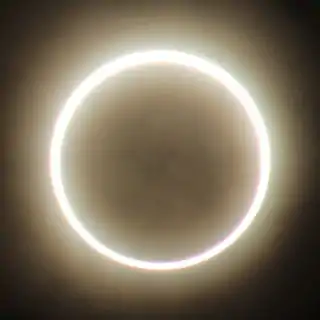Solar eclipse of February 28, 2044
An annular solar eclipse will occur on Sunday, February 28, 2044. A solar eclipse occurs when the Moon passes between Earth and the Sun, thereby totally or partly obscuring the image of the Sun for a viewer on Earth. An annular solar eclipse occurs when the Moon's apparent diameter is smaller than the Sun's, blocking most of the Sun's light and causing the Sun to look like an annulus (ring). An annular eclipse appears as a partial eclipse over a region of the Earth thousands of kilometres wide.
| Solar eclipse of February 28, 2044 | |
|---|---|
 Map | |
| Type of eclipse | |
| Nature | Annular |
| Gamma | −0.9954 |
| Magnitude | 0.96 |
| Maximum eclipse | |
| Duration | 147 sec (2 m 27 s) |
| Coordinates | 62.2°S 25.6°W |
| Max. width of band | - km |
| Times (UTC) | |
| Greatest eclipse | 20:24:40 |
| References | |
| Saros | 121 (62 of 71) |
| Catalog # (SE5000) | 9605 |
This is the last of 55 umbral eclipses of Solar Saros 121. The 1st was in 1070 and the 55th will be in 2044. The total duration is 974 years.
Images

Animated path
Related eclipses
Solar eclipses of 2044–2047
This eclipse is a member of a semester series. An eclipse in a semester series of solar eclipses repeats approximately every 177 days and 4 hours (a semester) at alternating nodes of the Moon's orbit.[1]
| Solar eclipse series sets from 2044–2047 | ||||||
|---|---|---|---|---|---|---|
| Ascending node | Descending node | |||||
| 121 | February 28, 2044 Annular |
126 | August 23, 2044 Total | |||
| 131 | February 16, 2045 Annular |
136 | August 12, 2045 Total | |||
| 141 | February 5, 2046 Annular |
146 | August 2, 2046 Total | |||
| 151 | January 26, 2047 Partial |
156 | July 22, 2047 Partial | |||
| Partial solar eclipses on June 23, 2047 and December 16, 2047 occur on the next lunar year eclipse set. | ||||||
References
- van Gent, R.H. "Solar- and Lunar-Eclipse Predictions from Antiquity to the Present". A Catalogue of Eclipse Cycles. Utrecht University. Retrieved 6 October 2018.
.jpg.webp)

